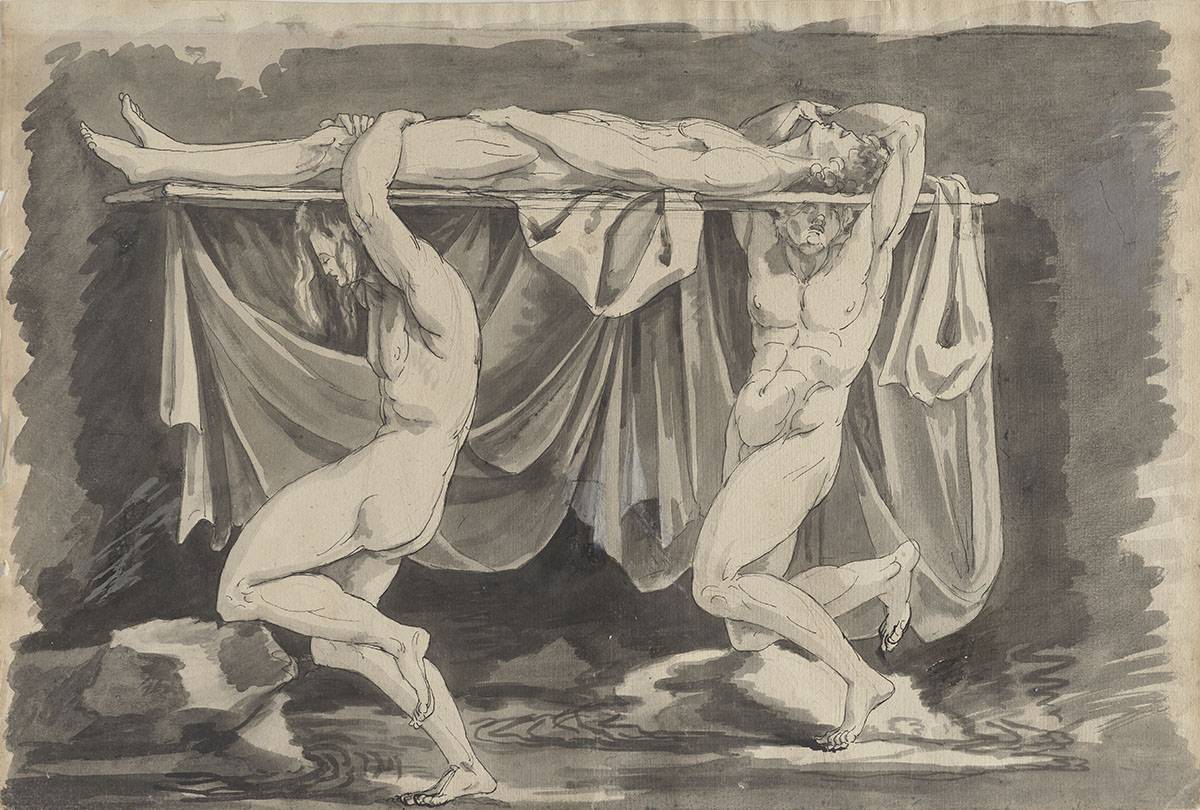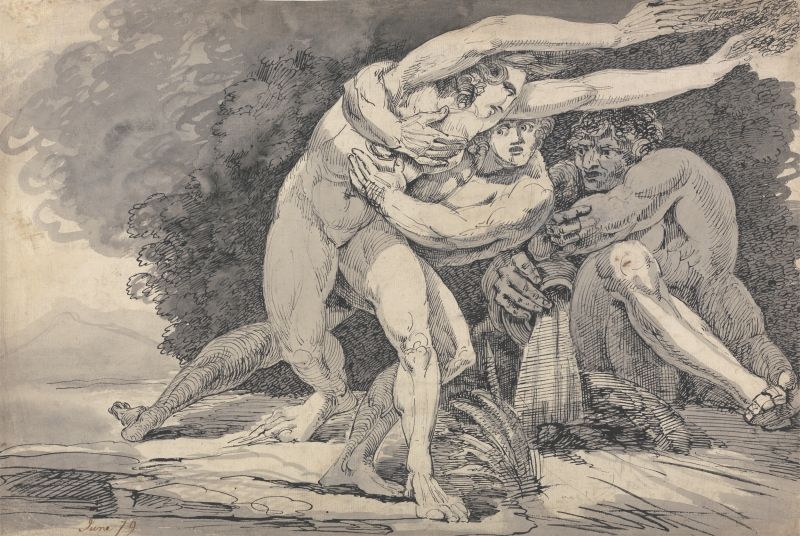This remarkably bold sheet comes from an album of drawings made in Rome in 1779. The album has stimulated periodic debate amongst scholars over the last forty years and the drawings have been variously attributed to James Jefferys and Prince Hoare. Executed in a distinctive manner, they are now recognised as exemplary of the violent imagination of British neo-classicism and widely regarded as some of the most graphically advanced works made in late eighteenth-century Europe.
This drawing belongs to a group, which comprise some twenty large sheets and a similar number of smaller sheets, which have been known since they were extracted from an album and exhibited by the London dealers Roland, Browse and Delbanco in 1949. Made in Rome and demonstrating a close interest in sculpture as well as Italian printmaking, they seem to have been drawn by a member of the international circle of artists who worked close to the Swiss painter Henry Fuseli. Various attempts have been made to identify the hand, who was christened by Roland, Browse and Delbanco: ‘The Master of the Giants’ on account of the colossal, heroic figures with attenuated limbs which characterise the majority of the sheets.
In the early 1950s both the collector Leonard Duke, who owned the present sheet, and the great Fuseli scholar, Frederick Antal, suggested that the album might be the work of the painter and sculptor Prince Hoare. Whilst Hoare is not universally accepted as the author, the present drawing corresponds closely to Hoare’s surviving work. Hoare arrived in Rome in 1776 and quickly established himself amongst artistic circles in the city, he is recorded living in the Strada Felice along with William Pars, Alexander Day and James Nevay. Hoare became particularly close friends with James Northcote, who recorded their frequent trips to draw in the Sistine Chapel. Both Hoare and Northcote were friends and followers of Fuseli. Fuseli arrived in Rome in 1770 and shortly afterwards began to produce highly inventive interpretations of literary subjects. In common with the sculptors Johan Tobias Sergel and Thomas Banks, Fuseli found in the prescribed diet of Raphael and Michelangelo, not classical harmony but vast, swollen heroic bodies engaged in violent actions, ingredients he recast to form a distinctive visual language. It was a language adopted by a circle of young painters and sculptors then studying in Rome.
Both Northcote and Hoare copied a number of Fuseli’s Roman sheets – Hoare’s drawing after The Death of Duke Humphrey of Gloucester survives in the British Museum and a copy of one of Fuseli’s five-point sketches is preserved at Yale – and both began producing compositions in a similar style. The geographic proximity of the painters, their personal intimacy and stylistic similarities has caused difficulties in working out questions of attribution for later scholars. We are afforded an idea of Hoare’s work from an autograph sketchbook from his Grand Tour consisting of over a hundred studies preserved in the Victoria and Albert Museum, London. These drawings offer further support for the attribution of the present sheet, given the handling of wash and expressive exaggeration of hands are comparable in both.
This fluidly worked sheet ranks as one of the grandest of the drawings from the Master of the Giants Album. As with so many of Fuseli’s boldest drawings, the present sheet shows impressive, muscular figures in action. The taut physique of the figures carrying the bier capture the dramatically overblown qualities of late Roman sculpture which Fuseli so admired. The precise subject of the present sheet is unclear, although the youth and noble bearing of the corpse suggest it depicts a hero slain in battle. This iconographical ambiguity marks many of the sheets from the album. The obscure subject-matter lies at the heart of the appeal of many of the sheets in the Master of the Giants Album, whatever the precise source, it is used by Hoare to create a dynamic image which allows him to play with a boldly arranged group of highly sculptural figures. Hoare revels in the license to distort, exaggerate and stylise showing the lead pall-bearer with impossibly attenuated limbs. It is in these grandly exaggerated figures we find the essence of the British response to the prescribed Grand Tour diet of the antique and high Renaissance classicism, which would fuel the creativity of such artists as William Blake in the following generation.



